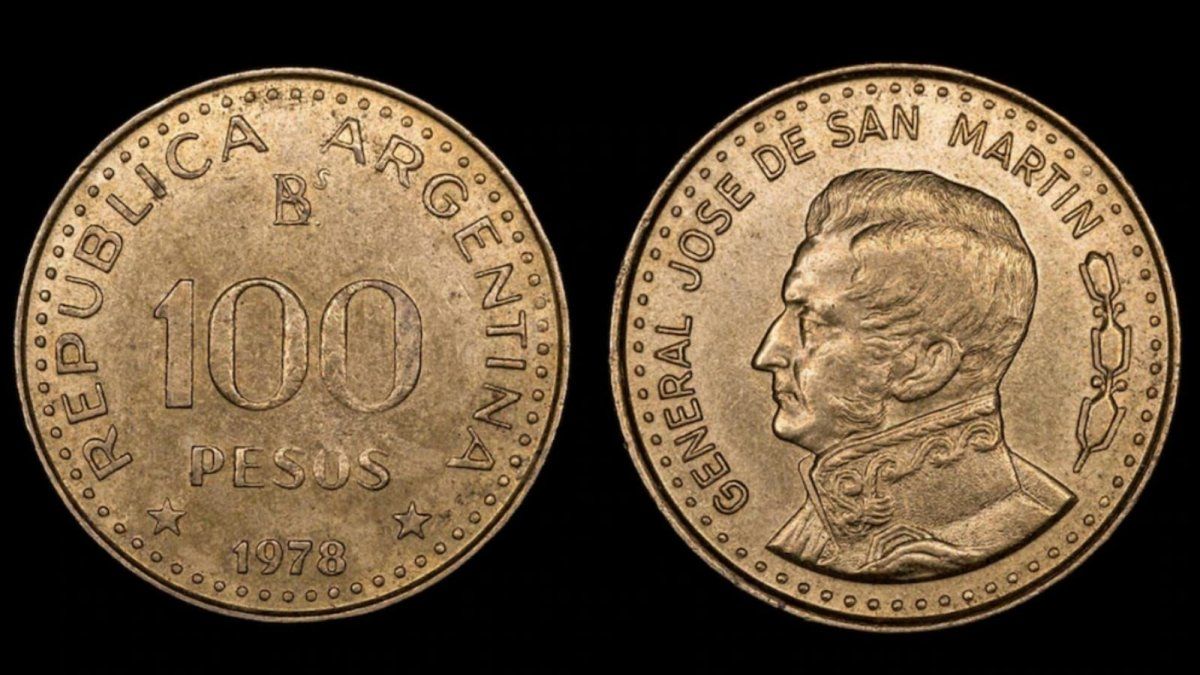Errors in minting coins They can transform everyday objects into coveted pieces. This is the case of the hybrid or mule coins of Argentina of 100 pesos Ley, minted in the late 70s. These stand out for their incorrect combination of designs on the obverse and reverse, an error that made them a treasure for the collectors with values between US$600 and US$1,250 depending on their rarity.
Where do hybrid currencies come from?
In 1978, the Mint decided to include a special design in commemoration of the bicentennial of the birth of José de San Martín. The 100 peso coins of that year bore the effigy of the hero on the reverse and, next to it, the dates “1778-1978”, a tribute to the anniversary. This special design was used exclusively during that year.
In 1979, the Mint stopped using this design and returned to a simpler model. Instead of the commemorative dates, a branch of laurels appeared next to the bust of Saint Martin, while the face value and year of issue were maintained on the obverse.. However, due to a minting mix-up, dies from different years and designs were mixed together, resulting in two unique versions of hybrid coins.
These coins had a unexpected combination of designs. For example, having the 1978 issue date on one side and, on the other, the laurel branch corresponding to 1979. Another version mixed the 1979 issue date with the commemorative dates of the bicentennial of Saint Martin, which should have been used exclusively the previous year.
Features of hybrid currencies
The rarity of these hybrid coins lies in their incorrect design combinationthe result of the accidental use of dies that did not correspond to the same year. These are the two main versions:
- Hybrid coin of 100 pesos Ley with the year 1978 and laurel next to San Martín:
- On the obverse: face value (100) and year of issue (1978).
- On the reverse: bust of Saint Martin accompanied by a branch of laurels.
- Estimated value: $600.
- Hybrid coin of 100 pesos Ley with the dates “1778-1978” next to San Martín and the year 1979:
- On the obverse: face value (100) and year of issue (1979).
- On the reverse: bust of Saint Martin next to the commemorative dates “1778-1978”.
- Estimated value: u$s1,250.
These pieces went into circulation normally, which explains why they can still be found stored in drawers or family chests.
hybrid coin san martin
These pieces went into circulation normally and can be found stored in drawers or family chests.
Rio de la Plata Numismatics
Hypotheses about its origin
One of the hypotheses about how these coins were produced states that, in 1979, dies were mixed up while pending minting orders were being completed. Another theory suggests that they may have been produced as a souvenir during an exhibition at the Rural Society.
There is even speculation that an employee intentionally created them to benefit from the high value they would achieve in the future. However, what is clear is that these coins one of a kind They capture the attention of collectors and numismatic specialists both inside and outside Argentina.
Market and current value
The hybrid currency market in Argentina is not as active as the financial marketsbut continues to generate interest among collectors. The prices of these pieces vary depending on their rarity and state of conservation. The most common hybrid coins, such as those bearing the 1978 date with the laurel branch, have been sold at auctions by $600equivalent to $695,055 at the current MEP dollar exchange rate.
In contrast, the 1979 version with the commemorative dates of the bicentennial reaches estimated values of u$s1,250that is, approximately $1,448,637.5. However, finding buyers for these prices is not easy, so sellers turn to numismatic houses for lower sales amounts than those at auctions. In this context, Purchase prices can drop between US$200 and US$300.
Counterfeit risks
Some people try to create fake hybrid versions cutting original coins and assembling the halves of different pieces. Fortunately, these forgeries are easily identifiable, as the edge of the coin clearly shows the cut. Experienced collectors and numismatic houses have the tools and knowledge to verify the authenticity of these pieces.
Additional details about the market
Although some of these coins can reach up to $1,448,637.5 at the MEP dollar exchange rateit is not always easy to achieve sales at these prices. Platforms such as Mercado Libre also have versions for sale, but specialists warn about the need to verify the authenticity of the pieces before making any purchase.
Source: Ambito
I’m a recent graduate of the University of Missouri with a degree in journalism. I started working as a news reporter for 24 Hours World about two years ago, and I’ve been writing articles ever since. My main focus is automotive news, but I’ve also written about politics, lifestyle, and entertainment.




